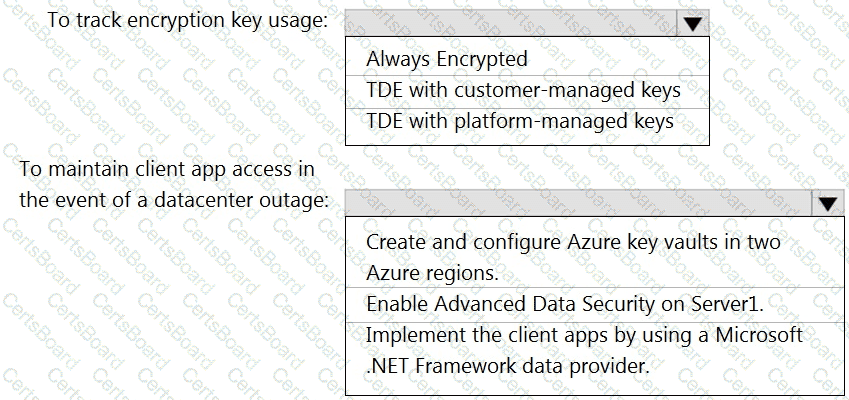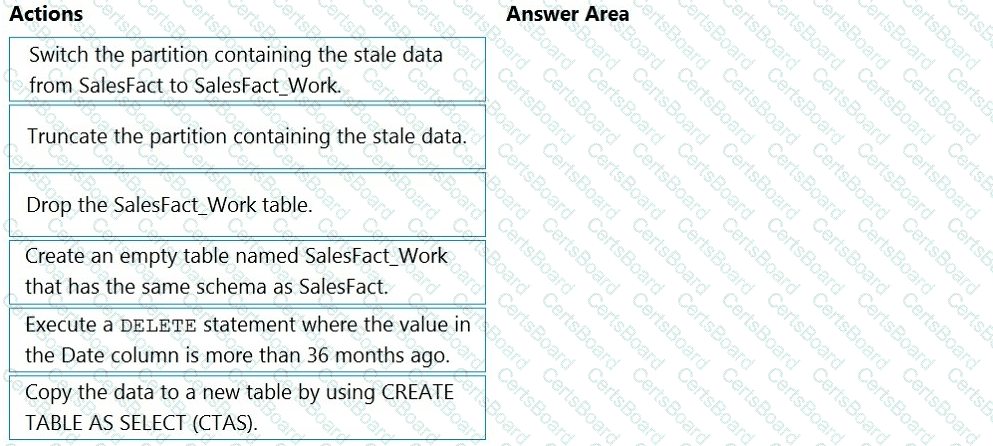You have an Azure subscription that contains an Azure SQL database named SQLDB1 and an Azure Synapse Analytics dedicated SQL pool named Pool1.
You need to replicate data from SQLDB1 to Pool1. The solution must meet the following requirements:
• Minimize performance impact on SQLDB1.
• Support near-real-time (NRT) analytics.
• Minimize administrative effort.
What should you use?
You have an Azure subscription that contains an Azure Synapse Analytics serverless SQL pool. You run the following query in the pool.

For each of the following statements, select Yes if the statement is true. Otherwise, select No. NOTE: Each correct selection is worth one point.

You have an Azure subscription that contains a logical Microsoft SQL server named Server1. Server1 hosts an Azure Synapse Analytics SQL dedicated pool named Pool1.
You need to recommend a Transparent Data Encryption (TDE) solution for Server1. The solution must meet the following requirements:
Track the usage of encryption keys.
Maintain the access of client apps to Pool1 in the event of an Azure datacenter outage that affects the availability of the encryption keys.
What should you include in the recommendation? To answer, select the appropriate options in the answer area.
NOTE: Each correct selection is worth one point.

You have an Azure Synapse Analytics dedicated SQL pod.
You need to create a pipeline that will execute a stored procedure in the dedicated SQL pool and use the returned result set as the input (or a downstream activity. The solution must minimize development effort.
Which Type of activity should you use in the pipeline?
You have a SQL pool in Azure Synapse that contains a table named dbo.Customers. The table contains a column name Email.
You need to prevent nonadministrative users from seeing the full email addresses in the Email column. The users must see values in a format of aXXX@XXXX.com instead.
What should you do?
You have an Azure Stream Analytics query. The query returns a result set that contains 10,000 distinct values for a column named clusterID.
You monitor the Stream Analytics job and discover high latency.
You need to reduce the latency.
Which two actions should you perform? Each correct answer presents a complete solution.
NOTE: Each correct selection is worth one point.
You have an Azure Synapse Analytics dedicated SQL pool that contains a table named Table1.
You have files that are ingested and loaded into an Azure Data Lake Storage Gen2 container named container1.
You plan to insert data from the files into Table1 and azure Data Lake Storage Gen2 container named container1.
You plan to insert data from the files into Table1 and transform the data. Each row of data in the files will produce one row in the serving layer of Table1.
You need to ensure that when the source data files are loaded to container1, the DateTime is stored as an additional column in Table1.
Solution: In an Azure Synapse Analytics pipeline, you use a data flow that contains a Derived Column transformation.
Note: This question it part of a series of questions that present the same scenario. Each question in the series contains a unique solution that might meet the stated goals. Some question sets might have more than one correct solution, while others might not have a correct solution.
After you answer a question in this section, you will NOT be able to return to it. As a result, these questions will not appear in the review screen.
You have an Azure Data Lake Storage account that contains a staging zone.
You need to design a daily process to ingest incremental data *rom the staging zone, transform the data by executing an R script and then insert the transformed data into a data warehouse in Azure Synapse Analytics.
Solution: You use an Azure Data Factory schedule trigger to execute a pipeline that executes a mapping data flow, and then inserts the data into the data warehouse.
Does this meet the goal?
You have a table named SalesFact in an enterprise data warehouse in Azure Synapse Analytics. SalesFact contains sales data from the past 36 months and has the following characteristics:
Is partitioned by month
Contains one billion rows
Has clustered columnstore indexes
At the beginning of each month, you need to remove data from SalesFact that is older than 36 months as quickly as possible.
Which three actions should you perform in sequence in a stored procedure? To answer, move the appropriate actions from the list of actions to the answer area and arrange them in the correct order.

You have an Azure subscription that contains an Azure Synapse Analytics dedicated SQL pool named Pool1. You have the queries shown in the following table.

You are evaluating whether to enable result set caching for Pool1. Which query results will be cached if result set caching is enabled?


